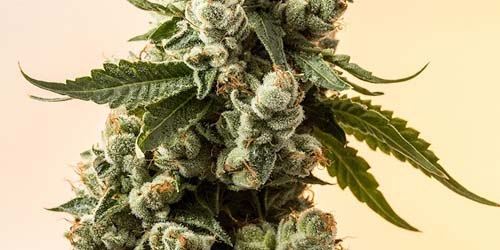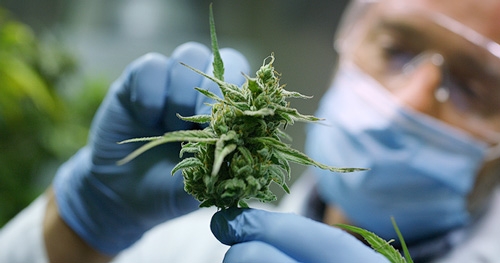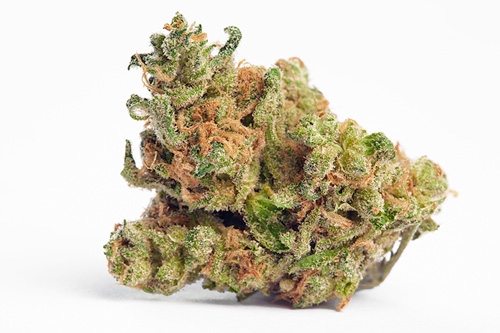
What makes weed the strongest weed? The THC content of course! At least, if you love high THC percentages. In this article, we review the strongest strains of weed; both the THC stars and the CBD champions. We also ask the question whether weed can become even stronger than it already is. Want to buy the strongest cannabis seeds from Dutch-Headshop right away? On to the next paragraph!
In this article:
- What is the strongest type of weed?
- The Theoretical Maximum THC Content
- Strongest Autoflower Weed
- Strongest weed in the Coffeeshop
- This is what you need to grow the Strongest Weed yourself
What is the strongest type of weed?
The cannabis seeds with the highest THC content that we sell are Fatkid's Cake (30% THC), Girl Scout Cookies (28% THC), Liberty Haze (25% THC) and Jack Herer (25% THC). In 2017, during the High Times Cannabis Cup in Southern California, the highest THC content and therefore the strongest weed was competed for. Godfather OG of CHR LA Private Reserve achieved almost 2 percent more THC with 34.04% THC than Sun Grow & Bib's Super Glue which took second place. Looking for weed with the highest CBD content? Then Herbal Solutions/Plant 4 2morrow's 4th generation Cannatonic grabbed the first prize with 22.77% CBD.
These are the official numbers. But it can be even crazier, if you want to believe non-independent test results. Gorilla Glue, also known as Original Glue or GG4, is often mentioned as an even stronger strain. Some GG4 weed buds even score 30% THC. Then we have The Toad, a cross between Girl Scout Cookies and Chemdawg from "the garden" of boxer Mike Tyson with a claimed THC content of 37%. Tyson has been a cannabis entrepreneur for some time after his boxing career.
The Theoretical Maximum THC Content
Another American strain, with the iconic name "Future # 1" from 7 points Oregon, caused commotion on social media. On Facebook and Instagram it was claimed that the weed contains 37.28% THC. Future #1 won the Oregon Dope Cup in 2017, but was then tested for 32.5% THC. Is the analysis wrong? Are analyses falsified to boost sales? Can such a percentage be achieved at all?

Mowgli Holmes, boss of the American Phylos Bioscience that continuously analyses cannabis samples, says that scientists in the cannabis world agree that the percentage of cannabinoids could be as high as 35% [3]. But the mechanism that blocks a higher THC content is not well understood. So could the percentage actually reach 37 or 38 percent? Holmes:
“The general consensus seems to be that the physical limit is gonna be around 35 percent, but we don’t really understand that, or why it is. We’re just guessing. So could a plant get to 37 or 38 percent? Maybe. Probably. Not impossible. It is pretty unlikely, though. The main point here is: Why the fuck would you want a plant that strong?” [3]
Holmes has a point. Why would you want weed that's that strong? Often that mega strong weed isn't even the tastiest or the best weed. If you're really THC crazy, then of course you can smoke or dab in hash or concentrates. Curious about the highest THC content? Here you can see the maximum percentages of THC in most types of weed and concentrates:
|
Cannabis presentation: |
max. THC percentage |
|
Weed (buds) |
35% theoretical, 34,04% measured [1] |
|
Hash |
66% measured [2] |
|
Weed oil (THC oil) |
from 10%* |
|
Wax |
50-80% theoretical |
|
Rosin |
more than 60% theoretical |
|
Ice-o-Lator Hash |
80% theoretical |
|
BHO / Shatter / Crumble / Budder |
70-90% theoretical |
*Homemade weed oil is diluted with vegetable oil in order to use it. The concentrate itself is many times stronger. Moreover, you use weed oil by dripping it, which makes the effect similar to a spacecake.

Shatter – a very strong concentrate from butane hash oil (BHO).
Strongest Autoflower Weed
The power of autoflowers is that they simply flow seamlessly into bloom, so you don't need a complex lighting scheme. You can also grow autoflowers outdoors faster, so you can often grow several times in a row in one season.
Common cannabis plants are the so-called photoperiod or often feminized cannabis plants, which need a shorter day length to start flowering. So less light per day.
The super power of autoflowers comes from the genetics of the ruderalis weed. Because autoflower weed has been crossed with a ruderalis weed plant, the percentage of cannabinoids and the yield is on average lower. CBD Auto Blackberry Kush from Dutch Passion produces a very respectable 15% CBD under good conditions. An easy to grow CBD star! We have two captains on a ship when it comes to autoflower THC. Leading the pack are Auto Bubble Gum and Auto Gelato, both with the genetics to deliver 22% THC in your own yield.
Strongest weed in the Coffeeshop
In the Dutch coffeeshops it is often the American import strains that currently contain the highest THC content. Strains such as Chemdawg (32% THC), Amherst Sour Diesel (27% THC) and OG Kush (24% THC) are some of the examples you sometimes see in the coffee shop. Compare that with the well-known Dutch Super Lemon Haze or White Widow, both of which are just below the 20% limit.
The weed from Dutch Barney's Farm can also be quite potent and these more unique hybrids are often found in the coffeeshop. We've mentioned one of these before: Liberty Haze (25% THC). Also Gorilla Zkittlez (24% THC) and the fairly new Dos Si Dos (28% THC) are found more and more in the larger coffeeshops.

This is what you need to grow the Strongest Weed yourself
When we talk about the strongest weed, we are talking about the genetics of the species. However, in addition to the genetics that optimize the production of cannabinoids, there are also external factors that are essential for growing strong weed:
A lot of (sun) light: We cannot emphasize it strongly enough. Light is the most important factor for large, healthy and strong cannabis plants. You can't expect a THC prize winner to actually produce ~30% THC behind thermopano. That simply doesn't bring in enough light. Put her outside in full sun, preferably in a place where the fence or trees don't cast shade during the day. For indoor weed cultivation use at least a 400 Watt grow light. With LED lighting the respective output is also often displayed.
Sleep: (Weed) plants need to sleep too. The metabolism changes completely as soon as a plant is in the dark for a longer period of time. Evidence shows that it is very important for both the yield and the strength of the weed to give your plants enough rest at night. So leave your lights off at night.
Good water management: Water your plant when she asks for it. Carefully insert your finger into the soil or coconut fiber and when the soil feels dry until your first phalanx, it's time to water it. Don't give too much water than needed and make sure there is good drainage: do not stamp the soil and add enough holes in the pot if you don't grow in full soil.
A balanced diet: Weed plants need food. Soil naturally contains nutrients, but it is quickly consumed when a weed plant is eating it. In addition to the mandatory growth and flowering nutrition, choose a root stimulator during the growth phase and a PK-booster or flowering stimulator during the flowering phase to maximize the percentage of cannabinoids.
Patience: Don't harvest your weed too early. Weed makes THCA and CBDA by means of a natural conversion of CBGA by enzymes in the plant. Take a look through a special weed microscope in the 6th week of flowering. Are the resin glands on the buds still transparent? Please be patient! When most of the weed has turned milky white, it's time to harvest your weed. Harvesting too early can mean that your weed could have converted more CBGA, so your weed could have been stronger. Don't harvest too late by the way, because mold is always lurking and when the resin glands turn brown you lose THC again to another natural conversion.
Too long; didn’t read it? Are your resin glands milky white? Time to harvest!
Drying and curing (even more patience): It doesn't only benefit the structure and taste of your weed: weed needs to be dried and cured. No worries. We can help you with that. Check the following blogs for everything about these crucial post-harvest processes: